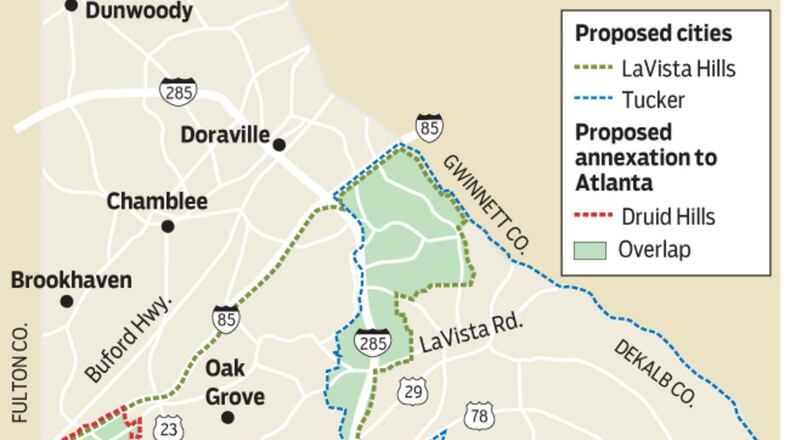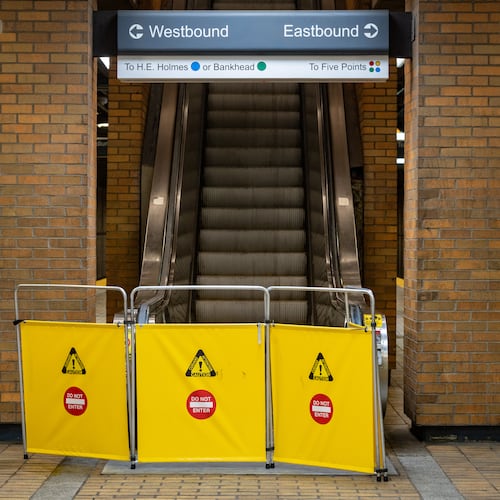What’s next
- A five-member panel of state representatives will step in to draw boundaries after the proposed cities failed to resolve their differences by a Saturday deadline.
- Those representatives, who will be chosen by House Governmental Affairs Committee Chairwoman Amy Carter, will create compromise maps before the end of the year. Those maps will be the only ones that will be considered by the committee.
- This legislative process was designed to solve local border disputes before state lawmakers consider whether to authorize the creation of new cities.
- Similar efforts to create cities fell apart during the legislative session this year because of disputes over boundaries.
- If the Legislature approves the cities, residents in those areas would then vote on their incorporations or annexations.
From Emory University to Spaghetti Junction, metro Atlantans raced to divvy themselves up into three cities Monday, efforts that could change the landscape of the region and give residents more say in their governments.
LaVista Hills and Tucker are trying to become new cities, and a group in Druid Hills is pushing to become part of the city of Atlanta.
They’re in for a border war before they get their way.
All three DeKalb County communities submitted overlapping maps Monday to state lawmakers, who will take over the contentious process of deciding which potential city gets what land. If approved by the Georgia Legislature next year, voters would get to decide whether to accept the cityhood and annexation proposals.
LaVista Hills is the newest possible city, combining 72,000 residents in the communities of Lakeside and Briarcliff that failed to achieve separate cityhood efforts in the Legislature earlier this year. Organizers announced the name of their hoped-for city Monday, and it would stretch from the affluent Druid Hills neighborhood beyond the intersection of I-285 and I-85.
But LaVista Hills’ boundaries conflict with those of Tucker and Druid Hills.
Tucker, a 122-year-old community that stretches east from Atlanta’s perimeter, has been fighting to keep the valuable Northlake Mall commercial property as part of its tax base that would be used to deliver services to 55,000 residents.
Druid Hills’ annexation would represent a tremendous expansion for the city of Atlanta, including Emory, the Fernbank Museum of Natural History and the Centers for Disease Control and Prevention. More than 22,000 residents live in the unincorporated part of Druid Hills.
“It’s an opportunity for communities to make their own decisions and set their own destiny,” said James Brooks, city solutions director at the National League of Cities. “Where it can ultimately create difficulties is where these lines on a map become more than just municipal jurisdictions and become havens apart from the region.”
Dissatisfaction with DeKalb County’s government has contributed to Tucker and LaVista Hills seeking a measure of political independence. The county has been plagued by accusations of corruption against its suspended chief executive, commissioners and former schools superintendent.
Mary Kay Woodworth, an organizer of the LaVista Hills Yes group, said cityhood would give residents a louder voice in local government decision-making. City council members would live in the same neighborhoods and be more responsive to residents.
“It’s not one of those efforts where we’ll be accused of seceding from the county or insulating ourselves from others,” Woodworth said. “It’s the complete opposite of that. It’s trying to do things better and smarter as part of a smaller entity.”
Druid Hills residents are more motivated by education, said Matt Lewis, a member of Together in Atlanta, the group formed to support annexation into Atlanta. They want their elementary schools and high school to become part of Atlanta Public Schools after the DeKalb County School District denied their petition for a charter cluster, which would have given them independent management of schools.
“Our focus is different from a new city’s focus. Our focus is on families and students and people,” Lewis said. “It’s important to keep together elementary schools. They’re the heart of these neighborhoods.”
Druid Hills would be a highly valued prize for the city of Atlanta and Mayor Kasim Reed, adding many jobs, homes and well-known landmarks to its territory.
“The mayor has seen the map and welcomes the area into the city,” said Melissa Mullinax, a senior adviser to Reed. “The mayor’s office will work with the area community leaders to bring this annexation proposal to a vote.”
With only about 450,000 residents in Atlanta — compared to 5.5 million people in the metro region — the city suffers from a natural divide between its inner and outer suburbs, said Christopher Leinberger, a professor for Georgia Washington University School of Business whose research has included Atlanta.
These fractured city governments aren’t uncommon in other large cities across the country, though Atlanta is among the smaller city centers compared to their regions, he said.
“It’s a great compliment to the city of Atlanta that a reasonably sophisticated area like Druid Hills would want to join,” he said. “You would have been laughed out of the cocktail party circuit in Druid Hills 20 years ago if you even brought that up as a random thought.”
Druid Hills, LaVista Hills and Tucker aren’t the only communities seeking cityhood.
The Georgia General Assembly may also consider proposals for cities of South Fulton, South DeKalb and Stonecrest in its upcoming legislative session. Meanwhile, annexations are proposed in Avondale Estates, Brookhaven, Decatur, Doraville, Lithonia and Stone Mountain.
About the Author
The Latest
Featured



